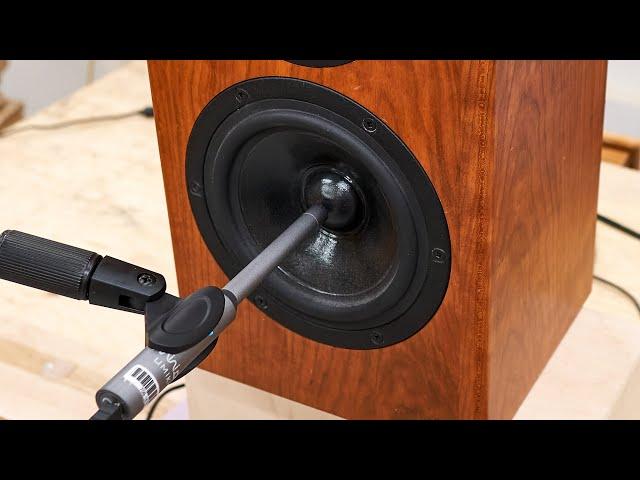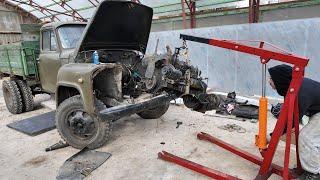
Why My DIY Speakers Sound Bad / Measuring With REW and UMIK-1
Комментарии:

Fascinating stuff John! As a fellow "speaker geek" I am delighted with your new direction!
I've been studying acoustics and speaker design since 1978, and STILL find it challenging!
So please keep up this speaker design, build and measuring content! I'm sure we'll all learn from it!

Don’t you want to measure in between the tweeter and woofer? The mic is right up on the woofer. Did you measure it like this? If you did of course the tweeter measurement will be way off.
Ответить
I guess this sounds like "I trying to look like a smart asshole" but FR does not need to be a perfectly straight line until you like the overall sound. Peaks in HF segment can be a good thing by giving nice clarity feeling without tearing ears apart. It seems you have whole lotta work to do with lows, cause deep LF are highly underpowered. most sound companies trying to make V-shape frequency response this days. at least - this is what mainstream market doing. I`m sure you know that.
Ответить
I have a set of Jantzen ja-8008 woofers to offer up for your use. They were designed by Troels Gravensen. Drop me a line if you're interested.
Ответить
Love it. Been a professional audio fabricator since 89. Back in the day with Phoenix Gold amplifies we HAD to build the crossovers for drivers. It's a wonderful hobby and discipline. We always used a small anechoic chamber chamber to measure the driver's response. We didn't have fancy computer software back then;)
Ответить
Subscribed:)
Ответить
What is the name of the software you used? I can’t make it out in the video.
Ответить
I am so glad you started this channel. Building speaker cabinets is how I got into woodworking.
Ответить
Great idea. Build different speaker cabinets, speaker stands, hifi racks/furniture, home cinema furniture/couchs.
Ответить
Dumb question, John - why not do this in the garden ('yard') for a 'free field' response? I remember doing that years ago at university. We also had a calibrated protractor to measure off-axis response. Very impressed with the fit & finish and your mastering the software. Subscribed. It's going to be an interesting ride! All the best, Rob in Switzerland.
Ответить
"How Heisz Hears It." you may use this name with great abandon. :)
Ответить
How is this channel not called Heisz Fidelity?
Ответить
In order to properly splice nearfield to farfield gated response, you need to process the nearfield for cabinet diffraction. Your low frequencies will shelf down ~6dB and you will get some response modification based on the distance from the driver to the baffle edges. Also sometimes offsetting the tweeter to one side and rounding over the baffle edges will tweak the tweeter response to be smoother.
Ответить
I'm guessing it was the waveguide for the tweeter and perhaps the square box with no enough rounded edges. Did you ever replace the tweeter?
Ответить
To avoid reflexions from walls you can do groundplane measurements inside, or even better outside.
Ответить
Interesting.
Ответить
John the mic is always set to 1 meter on axis or off. Your sweep should be set to have 1 watt peak to peak @ 1Khz or 2.38 V p-p AC.. Then take your measurements. I guessing your using REW for your measurement software. Also try constructing a baffle behind the microphone . That will eliminate reflection at the measuring point. Enjoy your videos. Have a wonderful day.
Ответить
To have a good phase around cutoff frequencies, you must put the tweeter behind the woofer. Thank's to ARTA or HOLMIMPULSE, you can verify the phase linearity : CSD on ARTA is linear around the cutoff frequencies ; Phase on HOLMIMPULSE is linear too. You can invert polarities but the best choice is to push behind the tweeter and measure a lot of time.
Ответить
Just found your channel John........very interesting. I also build speakers (sort of) I have a friend that does the custom crossover networks for me...........some can be really robust at about 5 pounds. Maybe we could swap speaker pics some time.
Ответить
I would like to see testing of different types of speaker stands. I've never seen anything definitive regarding use of materials or shapes that influence sound.
Ответить
Would love to see you do a build of active speakers using MiniDSPs 2 channel plate amps with Icepower and doing all the xover design digitally.
Ответить
Wait a minute, did I hear right that you use weight of wire to calculate crossiver?I always thought that inductance of coil is calculated if you know wire diameter, interval between neighbour winds of wire in coil and inner diameter of coil, but not weight. I see you unwind factory made coil to wind new coil, but are you sure it's ok? Maybe your speakers sound bad because of improperly calculated and made crossover?
P.S.: When I design crossovers for speaker project, I usually calculate it's components values at least in two or three crossover calculators to avoid mistake. Crossover frequency is important too. In 3-way speakers I prefer 200 Hz and 4-5 kHz frequencies between woofer and mids and mids and tweeter. The trick is that bigger part of sound should come from one driver. So mids must be best part of your speaker, because we hear mids best of all. As for 2-way speakers, I prefer 3-3.5 kHz between woofer and tweeted, usually works fine. And tweeter is usually loaded by II or III order Butterworth. As for mids, it is usually I order Butterworth, but mid-range driver must have extremely linear frequency response between 100-5000 Hz at least. If it is so, result will be good.

Not true, unless if its built off specs. It'd that simple
Ответить
I used to build drivers for a living, love the content
Ответить
I spaced my drivers too far apart too, but it's not noticable thankfully
Ответить
I had a high end audio system - and I really didn't like the harsh tweeter response at all. My wife purchased this cheap Sylvania audio system and it might not be as loud, but it made the music a 1000x more enjoyable then the high end system. You can hear the cymbals and snare drums so crisply on the cheaper system. It's a night and day difference when it comes to enjoying the music - I don't understand!
Ответить
If you don't have an anechoic chamber, wait for a windstill day and test your speakers outdoors. Test them on the lawn on a stand, not on concrete, wood, or anything that reflects.
It will give you a frequency response test without room interaction.
It doesn't work with cars and buses going by or planes flying around though, it has to be quiet :)

I'm still learning, when I saw the inductor weighing, ratio stuff, I kinda thought something was not right. But hell of a channel John. I love your videos. We'll keep learning together.
Ответить
One of the most common issues with DIY speaker builds is that they tend to completely ignore directivity. That's somewhat understandable as it can be quite a chore to perform the necessary simulations or manual CEA2034 spins but it also tends to negate much of the builder's work. When a passive or DSP-based crossover are designed based solely upon an on-axis response without proper simulation or off-axis data, the result is typically severe directivity nonuniformities which produce a completely different listening window and in-room response when ERs are summed. Unfortunately, this is also a problem which can never be fixed after the fact using EQ.
Proper directivity matching really needs to take place when drivers are being selected, with a degree of passive control also being engineered into the baffle itself. Where possible, a waveguided tweeter simplifies much of the design process.

What is the free software you are using for analysis?
Ответить
Can you please do a comprehensive video on REW and the UMIK. Setup and calibration. Thanks
Ответить
Build a set of horns! Youll never go back to monkey coffins after that
Ответить
Must sound bright
Ответить
John, why don't you build a speaker with a full range driver and a port, there are some fantastic full range speakers out there like the tang bang W5-1611SAF that gets great reviews on parts express. it would be cool to see how it sounds in an enclosure. thanks
Ответить
Why don't speaker manufacturers just post a graph now instead of a picture of the speakerz?! With the decline of av stores we have to unfortunately rely on only measurements now which is a shame. Measurements are absolutely not the end all be all but I guess that's what we have to work with right now. Oh well. At least its accurate.
Ответить
The only reason why I am watching this is to learn how to use the umik and you cut out
Ответить
cheap tweeters
Ответить
I don't think your loudspekaer is bad, but the room acoustics, the REW setup with sweeping sine in such a near-field measurement. We don't need a strong sine wave in a near field measurement as it merely brings unnecessary reflections.
Ответить
Just trust your earholes young man!!
Ответить
Baffle step?
Ответить
From the camera angle it looks like you measured it with the mic aimed at the woofer, you should have measured it at the tweeter level and in between the woofer and tweeter, measure it with one of the driver polarity inverted to check for the null at the crossover point, and also add some baffle step compensation.
Ответить
Excelente trabajo. Pero al medir en el taller la acústica de la sala afecta la medición.
Ответить
DIY Speakers will sound bad if you combine a soft woofer with a hard tweeter or the other way around.
Ответить
Im guessing the easy answer is like everybody you've got an excuse for everything
Ответить
How about forget the crossover entirely and use a stereo amp in each speaker to drive the cones separately. D-Class mosfet amps are dirt cheap, and technically it is a better solution as you can tweak it to get the crossover point and levels exact.
Ответить
Do you know how much the room modes and acoustics of the interference patterns generated due to the table in the room V.s how much is the actual response of the crossover? If you move that test to a closet full of clothes the response may look completely different.
Ответить
He knows nothing about loudspeakers at all, but his English is so well.
Ответить
that tweeter respone is disaster.. omg
Ответить

























